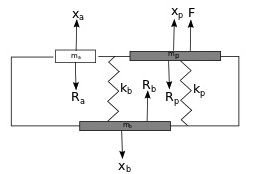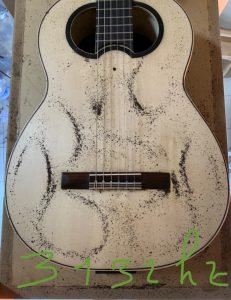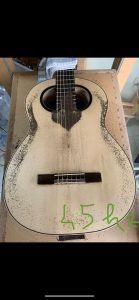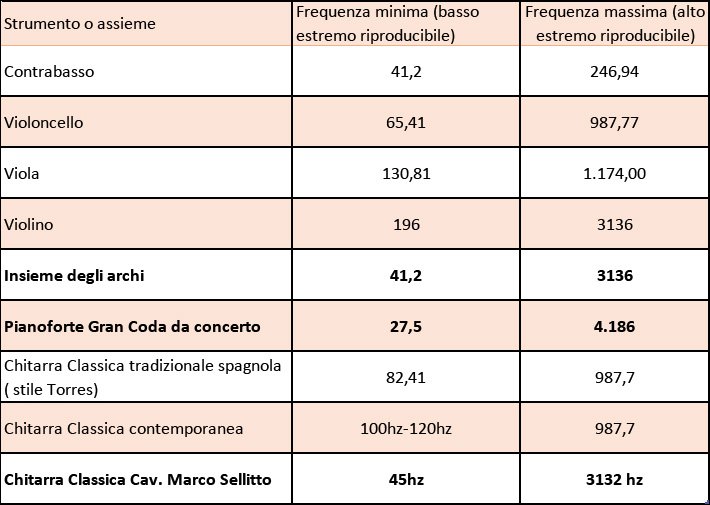CLASSICAL GUITAR
Cav. Marco Sellitto
The classical guitar is first of all a resonance box that vibrates: even if its sound starts from the strings, what we actually hear is the sound of its resonance box.
More specifically: :
When plucked the strings determine the origin of the vibration just like an oscillator does.
The bridge, glued on the soundboard, receives the vibrations of the strings, and through the soundboard carries them over to the whole resonance chamber of our instrument (therefore to the side bands and, through them, to the back).
The bridge is therefore the coupling element between these two oscillators: soundboard and strings. .
However, the string, being very thin, during its vibration displaces such a modest amount of air that it would not be enough to produce a sound of sufficient intensity ...
And here the soundbox of the instrument comes into play: the vibration generated by the string must be amplified, enriched with harmonics, a function handed over to the soundbox of the instrument, which uses the two elements indicated below: :
1) the vibrational properties of the soundbox: : first of all of the resonance board (soundboard) and then of the woods of the rest of the soundbox (back and sides)
2) the volume of air contained : within it which “resonates” in accordance with the law of Helmotz’s oscillator, thus amplifying the oscillatory motion (vibration) of the strings
The vibration of the box, in fact, sets in motion a large volume of air both inside the resonance box and around its body, thus producing most of the irradiated sound perceived by the listener and by the musician himself / herself.
The guitar soundboard has, in general, a circular sound hole (or, in our case, two semi-circular holes that in terms of surface are its equivalent). This increases the output level (reinforcement), especially at low frequencies, just like a bass-reflex loudspeaker. You get the sounds of the instruments you can hear in large concert halls.
Specifically, it so happens that the wood, as it vibrates, causes the surrounding air to oscillate through pressure variations in accordance with the principle of the Helmotz resonator. This is true both for the air inside and outside the case.
It gives rise to multiple modes of vibration of the air, which reinforces the low frequencies above all.
Therefore, when manufacturing an instrument – besides the resonance of the sound box – it is also necessary to take into account the modes of vibration of the air. Like any other material, air is characterized by particular resonance frequencies, which are directly related to the size and shape of the sound box and the sound hole, as well as its structural rigidity and therefore its ease or not to get vibrating.
Three-mass model of a classical guitar soundbox
From an acoustic point of view, and as far as the sound or resonance-box goes, the classical guitar can be schematized as a vibrating system consisting of 3 oscillators: the soundboard, the back, and the soundhole through which the air with its resonances (law of Helmotz) goes in and out the box, matching the soundboard and the back
This three-mass model can be schematized as follows:

Fig. 1 Three-mass model of the resonance chamber of a classical guitar
Where:
TThe soundboard and the back are treated as rigid mass pistons, respectively mp and mb of the effective areas Ap and Ab
1. mp is the mass of the soundboard
2. mb is the mass of the back
3. ma is the mass of the hole (pit)
4. Xp the range (amplitude) of the movement of the soundboard (during vibration)
5. Xp the range (amplitude) of the movement of the soundboard (during vibration)
Products:
1. Ap * xp = volumetric displacement of the soundboard
2. Ab * xb = volumetric displacement of the back
3. Aa * xa = displacement of the volume of air in the hole
Similarly, the related Ks represent the stiffness of the structural element and its losses (including radiation damping)INNOVATIONS PROJECT MARCO SELLITTO CLASSICAL GUITAR
Premise :
The original Sellitto bracing rests on the following observations and considerations:
1. With its geometry, any radial bracing always generates and marks off a precise and defined field of forces.
2. The area of this force field is the sound board.
3. By implementing the bracing a “permanent” tuning of the soundboard is created, which will determine its vibration modes and, consequently, those of the entire resonance chamber
4. In the past and contemporary history of classical guitar manufacture the purpose, and therefore the use, of the radial chains of the soundboard have always been misunderstood. Because luthiers had a narrow vision of it, they used them only as a means of stiffening the structure.
But over and above that, they have another function which paradoxically enough is even more important. Up until now no one had singled it out. It has instead become the mainstay in the new bracing project of the Sellitto guitar :
1) The radial bracing chains are like the veins in a human body, which carry the blood (that is the vibrations) from the vibrational heart of the instrument to the body (soundboard) and from it to all the elements of the sound box (back and sides) ...
2) Therefore, in addition to providing a structural stiffening (the only function which to date had been identified by luthiers of all times), the bracing chains of the soundboard are “primarily” dispensers of vibrational energy from the epicenter of the vibration to all the vibrational areas of the instrument, up to the most peripheral ones.
Bracing in Sellitto guitars makes the best use of these new principles:
My research began when I started to investigate which could be the real causes of the distortion present in the sound of the guitar.
I thus realized that the causes of the distortion were mainly two: the position of the sound hole on the soundboard and, even more, the position of the two master chains of the soundboard, which is usually placed above and below the sound hole.
Due to the way they are structured, they create a strong localized stiffening in an area that should instead generate vibrations.
All of this brings about disharmonies in the vibrations of the table and, consequently, it is responsible for those phenomena of distortion present in the sound of the guitar.
So I began to think if there was a way to minimize the distortion or if it was not possible to entirely eliminate it.
Researching this more closely, I realized that thanks to the position of the harmonic hole the solution was already there.
As early as 1929 Simplicio had in fact tried to solve this problem by moving the soundhole up on either sides of the fingerboard.
That notwithstanding, the main cause of the distortion in the sound of the classical guitar remained unsolved, namely the presence of the two master chains in the soundboard ...
From the very beginning I rejected the notion that in order to increase the intensity of the sound of a guitar one must necessarily modify its structure (which in the end it all comes down to making it more complex and heavier).
I had instead espoused the idea that in order to obtain the maximum sound performance one had to go in the opposite direction, not adding, but simplifying and removing everything that was not essential to the stability of the architecture. So, with this in mind, I looked for a solution that would allow me to solve this problem at its roots: to completely eliminate the master chains ...
Having carried out some structural calculations and related simulations, I was able to design and then create a chain that did not require two master chains.
This, without in any way compromising the structural stability of the soundboard which, as a matter of fact, from tensile and compression tests subsequently conducted on it, turned out to be even stronger and stabler than those with master chains.
From an acoustic point of view, the amount of sound colours that arose from it was to me a stunning surprise.
It gratified me for all the efforts I had made ... I felt like I was going from a black and white picture to one, at last, ... in full c_o_l_o_u_r_s_ _… _
Starting from the study of air resonances inside the sound box: from a structural point of view we have redesigned the entire sound box of the classical guitar, using the principles of acoustics such as to operate in a dynamic regime through a continuous adaptation of acoustic impedance between the air inside the sound box and the external air present around the sound box, with which there is a continuous exchange. In particular and at the same time we obtained an increase in efficiency of a value of the order of +30% as well as a reduction in harmonic distortion .
My passion for Tesla’s work has motivated me to study a particular treatment of the wood in order to create a molecular cohesion high enough as to make the soundboard so elastic that it can be bent into a U shape without the risk of breaking it.
It starts with thermo-chemical treatments based on potassium silicate all the way to treatments with electromagnetic waves, first at low and then at high frequency. They reorganize and orient the molecular structure of the wood which, thanks to the previous treatments, becomes more suitable to be “treated”. With this level of flexibility, the responses of the board to the vibratory modes of the strings are much more sensitive and wide, attaining a remarkable coloristic enrichment: it is like offering a painter a palette not only wider, but also infinitely more varied in color. In this way a sort of “short-circuit” is created between the player and his instrument, in which the instrument and the guitarist become a single living and creative organism, so that the offer of new colors induces the interpreter to adapt his own “orchestration” to the “organic” at his disposal. In other words, a sort of feedback is created which also transforms the performer.
Once an instrument is completed it is of fundamental importance to “measure” the acoustic performance achieved and measure any deviation that has been generated compared to those expected in the project phase.
TONAL QUALITY OF THE GUITAR:
In the musical evaluation of an instrument’s quality, three characteristics are primarily considered: sound volume, equality, and timbre in terms of tonal richness. .
I. The sound volume, an entity that can be easily measured quantitatively. It indicates the “amount of sound produced, how much of it propagates at a certain distance and reaches the ears of the listener”, placed at a certain distance from the sound source (from near and far to assess the projection) in large rooms, and be heard by a large audience. A sound level meter is the instrument used to measure this magnitude and is now available to everyone (now also downloadable with simple app on our smartphones)II. Equality or balance , is “the ability of the instrument to emit sounds of uniform intensity for all notes, with the same amount of force used to pluck the strings. It is a rather rare characteristic: in fact, almost all stringed instruments (both classical guitar and stringed instruments), present significant differences in intensity as the pitch of the notes’ changes, often when switching from one string to another, or when playing the same note on different strings. These differences in volume between one note and another are effects that mar the performance of a piece, and are mainly due to defects in the distribution of thicknesses in the boards.
III. The timbreis given by the superposition, different at each frequency and for each instrument, of the fundamental note and its harmonics, in other words the harmonic richness present in a given frequency interval that is being analyzed. It is strongly influenced by the frequency response of the instrument. Cymatics tests are above all necessary to evaluate this last aspect, that is to say the timbre quality, as well as the frequency extension of the musical instruments being tested. In fact, research has shown that the resonance frequencies of the body modes of the instruments do not correspond to a large or small value of sound radiation efficiency, it is instead the modal form that determines the efficiency of radiation. (Ian Perry “Sound Radiation Measurements on Guitars and Other Stringed Musical Instruments”, Cardiff University, UK). Again, the most significant values on which to focus while studying radiation efficiency for classical guitars are between 150 Hz and 450 Hz (an Perry “Sound Radiation Measurements on Guitars and Other Stringed Musical Instruments”, Cardiff University, UK). Ancora, i valori più significativi e su cui convergere lo studio dell’ efficienza di radiazione per le chitarre classiche si trvano tra 150 Hz e 450 Hz ((Ian Perry “ Sound Radiation Measurements on guitars and other stringed musical instruments” Cardiff University UK).
Why vibrational analysis? :
Through the study of Chladni modal figures the vibrational behaviour of classical guitars, as well as of violins, is well understood. Many studies have been done in this sense, especially for the guitar (the relevant scientific literature, in this direction, is extremely exhaustive). The sound emitted by the classical guitar, as we have seen, derives from an absolutely coherent vibrational and acoustic component: the vibrational behaviour, in fact, describes the transfer of energy from the strings to the body, and the vibrational modes of the guitar’s sound box, which, with their vibration, generate the acoustic behaviour, represented by the sound radiated by the movement of the body. This is the reason why for decades the international scientific community found it much more responsive to what is to be ascertained in reality, In terms of effectiveness and completeness of the information obtained, one must study and analyze musical instruments (especially if valuable as in the case of Stradivarius, Amati, etc. etc.) through the study of the figures of Chladni (cymatics), rather than with other methodologies. However, thanks to cymatics, the behaviour of various instruments has been widely described and deepened, and as it can be seen there is ample literature and scientific documentation on it. Nonetheless the acoustic behaviour of classical guitars, until now, had not been studied to the same extent of the vibrational behaviour.
Chladni’s measurement methods:
Each part of the wood vibrates with a different intensity, and these different intensities are visualized by the nodal and antinodal lines. Nodes and antinodes are different depending on the frequency at which the table vibrates, and therefore each resonance is characterized by a particular nodal configuration.
The vibrational modes generated as a result of the various sinusoidal frequencies forcibly applied to the table are a function of the chaining (project) implemented on that particular soundboard.
From CIMATICS (theorized by Hans Jenny), of which the greatest precursor was Ernst Chladni, we know that vibrating bodies produce figures with high symmetrical shape, between nodal and antinodal areas of a surface with specific resonant frequency: the greater the number of modal figures, the greater the symmetry of the figures generated and displayed on the soundboard, the better will be the qualitative performance of the corresponding instrument.
Thanks to the wide experimentation carried out worldwide by various scholars and universities on the correlation between the sound of the instruments and the cymatic theories, we know that in qualitative and quantitative terms it is possible to study in a complete and reliable way a violin or any string instrument as well as a classical guitar by generating and analyzing the vibrational modes. As a result of forced sinusoidal frequencies, these are generated on the soundboard and are the outcome of the interaction between the three main vibrational masses (soundboard, bottom, and air vibration that couples soundboard and bottom).
If we put some coffee powder or similar material on a vibrating plate and apply to it a sine wave at certain frequencies, this powder will assume particular shapes, giving us the possibility to verify which and how many are the vibratory modes of a particular soundboard and its soundbox, descrying real figures, thanks to the observation and morphological analysis of nodal and antinodal figures that are displayed on the soundboard.
The number of modal figures and their symmetry are directly proportional to the vibrational and acoustic quality of the instrument under analysis.
Soundboard resonance configurations
How are the mechanical properties of wood related to the resonances of a board and, in the case of stringed instruments, to which values of these physical quantities correspond good musical results of the sound produced? The first to study the resonance modes of violin plates, with the aim of clarifying what these relationships were, were the physicist Felix Savart (1791-1841) and the luthier Jean-Baptiste Vuillaume (1798-1875). Beginning in 1830 they performed experiments on a dozen violins made by Antonio Stradivari and Giuseppe Guarnieri more than a century earlier. After Vuillaume and Savart, the Nobel Prize winner Chandrasekhara Venkata Raman (1888-1970) was the first to explain exhaustively a particular phenomenon called “wolf note”. Other physicists and luthiers to remember are the physicist Frederick Saunders (1875-1963), and the luthier Carleen Hutchins (1911-2009). In 1950 Carleen Hutchins, a luthier, and Frederik Saunders, a physicist, began a series of studies on the resonances of free soundboards, trying to explain in particular how these were related to the resonances of the whole instrument, as well as to its tonal characteristics. To do this, they applied Chladni’s method on about 160 instruments, both ancient and others built especially for their experiments. Hutchins and Saunders analyzed the various modes of vibration of the harmonic plane and bottom and the frequencies at which the various modes occurred.
Our soundboard resonates at particular frequencies, a function of the characteristics of the wood and of the chaining implemented, which permanently tunes the soundboard and determines their number and their vibrational modes..
Analyzing the results of more than 800 tests, they came to confirm the absolute validity and completeness of Chladni’s method for determining the quality of a musical instrument, which over the years has become the international standard by which scholars and luthiers analyze musical instruments.
By means of a loudspeaker one causes the soundboard to vibrate at a specific frequency and observes how black tea powder spreads on the soundboard.
Changing the frequency of this vibration shows at what point the dust grains jump the most; these frequencies are called the resonant frequencies of the board.
The dust grains are arranged following precise geometries made up of nodes and antinodes: clearly the dust will tend to accumulate at nodal points, i.e. in those points where the amplitude of the sound wave is zero. Whereas where the amplitude is maximum or minimum, at the antinodes, the dust will be blown
Modal Analysis:
:
CAs for violins, so for the classical guitar too we know that the vibrational modes (i.e. the morphological configurations which can be visualized, either with indirect techniques such as laser, holography, or direct ones such as tea dust), are 5 and are classified as vibration modes.
We have: :
- mode 1: generally present twice, first at the Helmotz frequency of our sound box “A0” and, second, at ca 185hz;;
- mode 2: present at the frequency of about 285hz;
- mode 3: present at the frequency of about 460hz;
- mode 4:present at the frequency of approx 510hz;
- mode 5:present at the frequency of 645hz illustrated here under
We report below some photos taken on the modes displayed by the Sellitto guitar :
Some examples of MODE 1 (A0), displayed:
We have resonance of the (mode 1 A0), already at 45hz, then at 61hz,70:
Remarks:
From the photos of the modes displayed on the soundboard, we can observe:
1. Numerous frequencies at which the main modes occur (e.g. the frequency of resonance of the box: remembering that the sixth open string is an E, with tuning 440
hz; ir corresponds to about 83hz; our box has a fundamental resonance already at 45hz ( MODE 1- A0). As bass sounds go, it is capable of generating bass sounds
about one octave lower than the lowest note of the guitar (sixth string, empty). It has moreover other modes 1, respectively 61hz and 70hz ). It presents as well
mode 5 as many as 7 times, and more precisely at the following frequencies: 587, 613, 650, 890, 1222, 1362, up to the frequency of 3132 hz (whereas, in terms of
fundamentals, it is the highest note on the guitar, first string, 19th fret) = 987 hz, which corresponds to a B; our 3132 hz correspond to a sound about two octaves
higher).
2. The perfect symmetry of the visualized figures that prove to us that there is an ideal Q factor.
3. High bass frequency extension: 45hz (which corresponds to the deepest bass attainable by a double bass)
4. High treble frequency extension: 3132 hz (which corresponds to the highest treble frequency attainable by a violin).
5. The constant presence of resonance at all significant frequencies shows a response which is harmonically rich, of high intensity and absolutely regular and uniform.
The character of the guitar and its quality factor is well evidenced and influenced by the frequency response that it presents in the range of frequencies ranging from about 150hz to about 450hz[1]. We have also made a spectral analysis below, which testifies to the absolute operational validity of the cymatic method, for the qualitative analysis of the instruments. For ease of viewing we have placed them side by side in the same graph. For convenience we have reported the graphs of the frequency response of 1-2-3 Sellitto guitars in the range 150Hz-450Hz:
[1] Jurger Meyer “ acoustic and the performance of music—Classical Guitar” ; “Dynamic response optimization on an classical guitar” M.M.A.Von Boven.

Spectral Analysis (150hz-450hz) compared, from left to right:
guitar 1( latex brace project)
guitar 2(Double Top project)
guitar 3 (Hauser project) Sellitto guitar (last on the right)
Note that while the frequency responses of all the guitars which were tested are completely distorted and irregular, the outcome of the test conducted on the Sellitto guitar is almost a straight line. It is always completely “full”, and therefore rich in harmonics. This response, which it both rich and linear, is due to the frequency numerosity at which the fundamental resonance modes occur and to the high extension of the frequency response of our instrument (45hz – 3132hz), which “fills” all the harmonic spectrum of the guitar with harmonic components.
With these last tests we have also demonstrated the last point, namely the absolute harmonic richness and uniformity of the Sellitto guitar’s response, compared to all the others tested.
Conclusions and strengths of the Sellitto guitars:
Thanks to the innovations and integrations adopted in the wake of the Sellitto project after conducting the final tuning tests on an already built guitar I obtained the following results:


7) Increased amount of colour and timbre nuances of the soundboard.

Table 1
As you can see from the table above, the guitar built according to my project can cover a very wide range of frequencies








